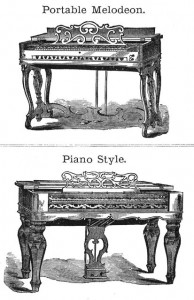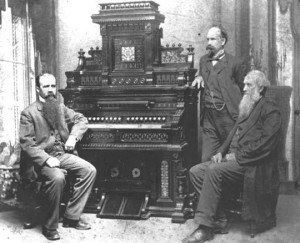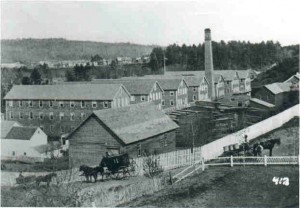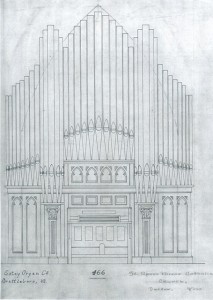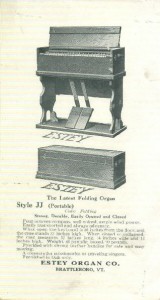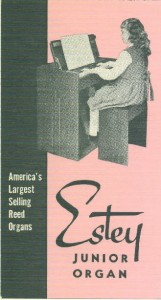The history of the Estey Organ Company is a complex story which traces the roots of industrialization in the Northeast, the beginnings of modern marketing, and the democratization of American music-making. Below is a very brief chronology of the Estey Organ Company. For a comprehensive examination of the company, we recommend the book, Manufacturing the Muse by Dennis Waring.
The Estey Years: 1852 – 1953
1846 Origins of the Estey Organ Company
Samuel and Joseph Jones arrived in Brattleboro and began producing hand-crafted melodeons. They were soon joined by Riley Burditt.
1852/1853 Jacob Estey Enters Melodeon Business
After several changes of ownership and modest success, Jacob Estey bought a share of the melodeon company as a business venture.
1855 Estey & Green Partnership
Jacob Estey and H. P. Green took over the company as partners. By 1859, Estey & Green were manufacturing 30 melodeons per week. With the arrival of the railroad in Brattleboro, instruments could be ordered by mail and shipped all over the country. The most popular model produced by Estey & Green was the Perfect Melodeon.
1863 Estey & Co. Formed
Jacob Estey took over sole ownership of the company. Needing capital for expansion, Estey took on additional partners the following year. Estey introduced the Cottage Organ into the Estey line. By the end of 1865, Estey was producing approximately 100 instruments per month in 30 styles.
1866 J. Estey & Co. Formed
The company reorganized with Jacob as president, son-in-law Levi Fuller, vice president, and son Julius J. Estey, secretary. By the end of the 1860s, the Cottage Organ had supplanted the melodeon in popularity. By 1869, production exceeded 300 instruments per month.
1870 “Esteyville” Established
After two fires and two floods, Estey relocated its manufacturing to slate-shingled buildings on Birge Street in Brattleboro. (One of the buildings is now home to the Estey Organ Museum.) Land on the hill behind the factory was made available to employees to build their homes.
1872 Estey Organ Company Formed
The company incorporated with Jacob Estey as president, Levi Fuller, vice president, and son Julius J. Estey, secretary and treasurer. The company continued to expand, increasing production to 700 instruments per month.
1888 Milestone Attained
The company celebrated the production of its 200,000th organ. The following year, the output reached 13,000 instruments.
1890 Passing the Torch
Upon the death of Jacob, Julius J. became president of the company. In 1892, the 250,000th organ was produced with a large celebration; organ 300,000 was produced before the turn of the century.
1901 Estey Pipe Organs
With the popularity of reed organs beginning to wane, Julius J. turned to the production of pipe organs. Well-known organ builder and inventor William E. Haskell was brought from Philadelphia to head the pipe organ department.
1902 Third Estey Generation
Jacob Gray Estey and Julius Harry Estey, sons of Julius J., took over the business upon the death of their father. By 1916, reed organs and pipe organs contributed equally to the company’s income.
1920 Fourth Estey Generation
Jacob Poor Estey and Joseph Gray Estey, sons of Jacob G., and Paul Chase Estey, son of Julius H., became the 4th generation in the family business. During the 1920s, pipe organs became the dominant product, and sales continued to increase.
1933 Estey Organ Corporation Formed
During the Great Depression, organ sales dropped dramatically. The company went bankrupt and assets were sold. In 1933, Jacob P. and Joseph G. reformed the company. Although the production of reed and pipe organs continued, the company experimented with various types of specialty instruments. During World War II, Estey produced most of the folding organs used by U.S. Army chaplains.
1950 Return to Family Control
Full control of the company returned to the Estey family with Jacob P., his nephew Wilson G Estey, and son-in-law Robert Cochrane, Jr. as partners. By the early 1950s, the company had manufactured nearly 500,000 reed organs and over 3,000 pipe organs.
1952 Largest Estey Pipe Organ
Estey installed its single most expensive pipe organ at Florida A&M College.
1953 Estey Organ Company Sold
Rieger Organ, Inc. of New Jersey became the majority stockholder in Estey Organ Company, ending the Estey family’s control of the company.
The Corporate Years: 1953 – 1961
1953 Estey Organ Company Name Maintained
Through the late-1950s, the Estey Organ Company continued to manufacture primarily compact pipe organs in the Brattleboro facility.
1954 Electronic Organs Introduced
The company introduced its first electronic organs, designed by noted German sound engineer Harald Bode.
1960 Brattleboro Facilities Closed
After a number of corporate changes, the company, now Estey Electronics, Inc., moved to California, signaling the end of the reed and pipe organ manufacturing in Brattleboro.
1961 Buildings Sold
The Estey factory buildings in Brattleboro were sold and the contents destroyed.
Sources:
Manufacturing the Muse (Waring)
National Register of Historic Places Nomination (Henry)
The American Reed Organ and the Harmonium (Gellerman)

